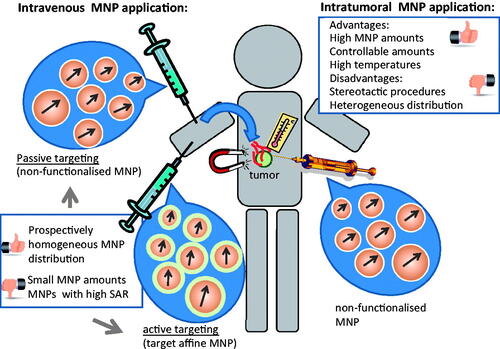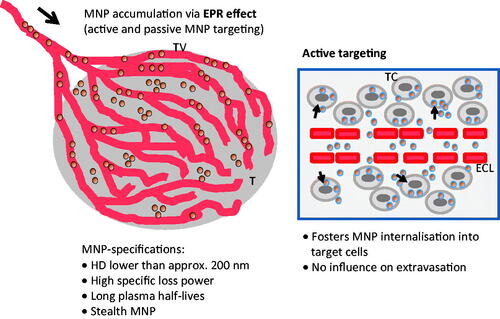Figures & data
Figure 1. Different magnetic nanoparticle application routes and their implication for magnetic hyperthermia. MNP, magnetic nanoparticles; SAR, specific absorption rate.

Figure 2. Intratumoral nanoparticle distribution patterns according to dependence upon different application routes. Intratumoral application: heterogeneous distribution as a result of the high interstitial pressure of tumour tissue. Active and passive targeting leads prospectively to a comparatively homogeneous distribution around the vessels of the vital tumour area. Nanoparticle retention during passive targeting is due to the lack of lymphatic drainage in tumours. Active targeting prospectively leads to increased retention compared to passive targeting on the basis of augmented internalisation into cells after specific ligand binding. There are ongoing discussions that only 1 to 10 % of the intravenously injected dose are will end up in the tumour region [Citation56] as well as on how active targeting favours nanoparticle accumulation in tumours. MNP, magnetic nanoparticles.
![Figure 2. Intratumoral nanoparticle distribution patterns according to dependence upon different application routes. Intratumoral application: heterogeneous distribution as a result of the high interstitial pressure of tumour tissue. Active and passive targeting leads prospectively to a comparatively homogeneous distribution around the vessels of the vital tumour area. Nanoparticle retention during passive targeting is due to the lack of lymphatic drainage in tumours. Active targeting prospectively leads to increased retention compared to passive targeting on the basis of augmented internalisation into cells after specific ligand binding. There are ongoing discussions that only 1 to 10 % of the intravenously injected dose are will end up in the tumour region [Citation56] as well as on how active targeting favours nanoparticle accumulation in tumours. MNP, magnetic nanoparticles.](/cms/asset/027cd06e-cb62-4de7-a28d-b45f9d724dcd/ihyt_a_832815_f0002_b.jpg)
Figure 3. The main rules governing active and passive targeting for magnetic hyperthermia. Both active and passive targeting are based on the EPR effect. Via active targeting nanoparticle internalisation into target cells in augmented. TV, tumour vessel; T, tumour; TC, tumour cell; ECL, endothelial cell layer; MNP, magnetic nanoparticle; HD, hydrodynamic diameter; MNP, magnetic nanoparticles.
